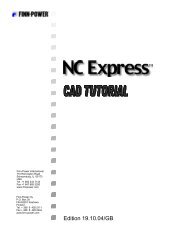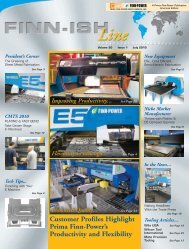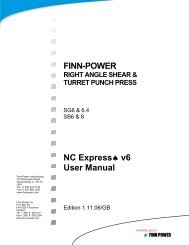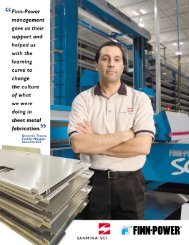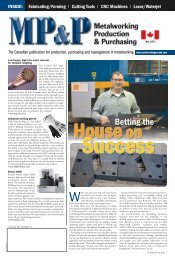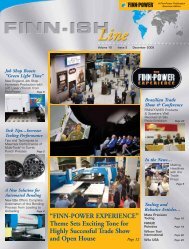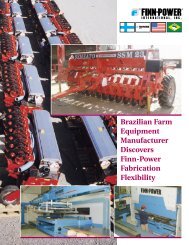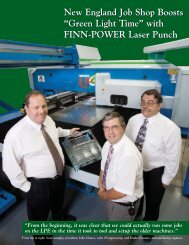Tooling Articles... Advanced Automation Enhances ... - Prima Power
Tooling Articles... Advanced Automation Enhances ... - Prima Power
Tooling Articles... Advanced Automation Enhances ... - Prima Power
Create successful ePaper yourself
Turn your PDF publications into a flip-book with our unique Google optimized e-Paper software.
POWERLINE<br />
CUSTOMER<br />
PROFILE<br />
Turbine engine repair and refurbishing is a rapidly growing business<br />
requiring specialized equipment and experience. Leading engine<br />
manufacturers are more frequently outsourcing this activity, demanding<br />
the highest quality work from their suppliers. This requires a dedication<br />
to continually improving the laser processes and quality while providing<br />
fast turnaround time.<br />
TL Precision Welding,<br />
Inc. of Houston,<br />
Texas, is a 12-person<br />
laser contract shop<br />
started in 1997 that<br />
serves this important<br />
and growing area of<br />
the turbine engine<br />
industry. Quang Tran<br />
originally founded the<br />
company to provide<br />
fabrication services<br />
to the Houston<br />
industrial market.<br />
Tran emigrated<br />
from Vietnam to<br />
the United States in<br />
1978. He has lived<br />
and attended schools<br />
in the Houston area, graduating from Texas A & M with a Bachelor of<br />
Science degree in biochemistry and chemical engineering.<br />
Success at TL Precision’s early engine refurbishing work has led to new<br />
opportunities in laser processing, company growth and a broadening of<br />
the company’s laser capabilities. In an era of general economic decline,<br />
this is an industry niche with promising growth simply because of the<br />
sheer number of turbine engines, both land-based and aero engines, in<br />
operation and the constant need for engine maintenance. One leading<br />
turbine engine manufacturer for aircraft alone reports 25,000 engines<br />
in active service, all of which are continuously monitored for periodic<br />
maintenance.<br />
The high value engine components, such as turbo combustors, nozzle<br />
guide vanes, blades and other transition parts, for both land and<br />
aerospace engines, are regularly refurbished and put back into service.<br />
To keep maintenance costs as low as possible and to extend time<br />
between overhaul, engine manufacturers are requiring suppliers like TL<br />
Precision to improve their processes.<br />
TL Precision has met this challenge by becoming an expert at<br />
refurbishing these components but also positioning itself with new<br />
equipment and skills to handle new laser machining work as well. In<br />
2008, TL Precision purchased their second system from LASERDYNE<br />
SYSTEMS (now <strong>Prima</strong> <strong>Power</strong> Laserdyne) maintaining a tradition<br />
commonplace for LASERDYNE SYSTEM users. TL Precision uses these<br />
systems for drilling difficult to machine materials such as Inconel 617,<br />
Titanium and Hastelloy X. These are the base materials used to make<br />
land based gas turbine engines.<br />
22 December 2011<br />
Refurbishing Turbine Engine Components with<br />
<strong>Prima</strong> <strong>Power</strong> Laserdyne<br />
Quang Tran, president, and Son Dao, operations<br />
manager, of TL Precision Welding, Inc., stand adjacent to<br />
a refurbished gas turbine component laser processed<br />
with the company’s LASERDYNE 790 BeamDirector<br />
system. The laser process is underway where cooling holes<br />
are “recreated” in the same position and of the same<br />
specification as the original new part.<br />
The result – the company is attracting substantial new laser<br />
processing work.<br />
Recreating Turbine Engine Holes<br />
A significant amount of engine overhaul calls for the repair and<br />
refurbishing of engine components’ air flow holes. Large combustor<br />
components have thousands of these small airflow holes of various<br />
sizes and shapes. The holes are designed to maximize engine thrust by<br />
selectively cooling critical components and are precision drilled using<br />
laser processes in carefully plotted, complex patterns over the part’s<br />
contoured surfaces. The holes also are contoured and angled to the<br />
part surface to maximize air flow, reduce engine noise and minimize<br />
fuel requirements. Hole angles vary from 90° to just 20° to the<br />
surface and require a high degree of complex and agile positioning and<br />
dimensional precision.<br />
According to Tran, the challenge with refurbishing air flow holes in<br />
these complex parts is that they must be “re-created” in the same<br />
position and with the identical precision size characteristics as the<br />
original part when new. “Recreating precision holes in a used part<br />
is often more difficult than generating precision holes in a new part,”<br />
explains Tran. “In recreating the hole, there’s no margin for error<br />
because most of these holes are positioned closely together and have<br />
diameters as small as .020 inches and require tolerance accuracies<br />
as tight as ±.002 inches. To position and laser process each of these<br />
holes accurately - without damaging the part - requires the very best<br />
multi-axis laser machining technology and a high level of operator skill.<br />
We have both with the LASERDYNE 790 system, the LASERDYNE<br />
BeamDirector and the continuing support of LASERDYNE SYSTEMS.”




